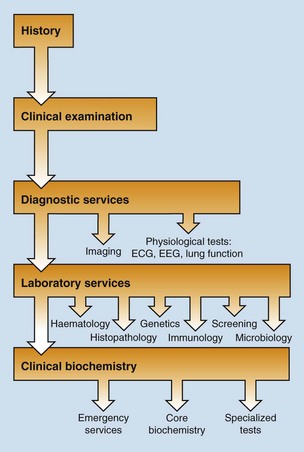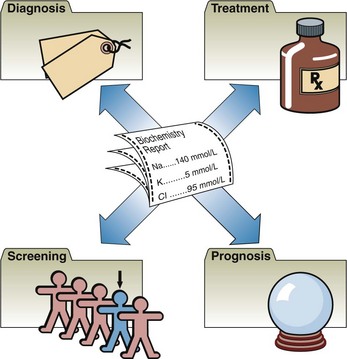The clinical biochemistry laboratory
Clinical biochemistry, chemical pathology and clinical chemistry are all names for the subject of this book, that branch of laboratory medicine in which chemical and biochemical methods are applied to the study of disease (Fig 1.1). While in theory this embraces all non-morphological studies, in practice it is usually, though not exclusively, confined to studies on blood and urine because of the relative ease in obtaining such specimens. Analyses are made on other body fluids, however, such as gastric aspirate and cerebrospinal fluid. Clinical biochemical tests comprise over one-third of all hospital laboratory investigations.
The use of biochemical tests
Biochemical investigations are involved, to varying degrees, in every branch of clinical medicine. The results of biochemical tests may be of use in diagnosis and in the monitoring of treatment. Biochemical tests may also be of value in screening for disease or in assessing the prognosis once a diagnosis has been made (Fig 1.2). The biochemistry laboratory is often involved in research into the biochemical basis of disease and in clinical trials of new drugs.
Core biochemistry
Biochemical facilities are provided in every hospital, although not necessarily to the same extent. All biochemistry laboratories provide the ‘core analyses’, commonly requested tests that are of value in many patients, on a frequent basis (Table 1.1). The clinician will often request specific groupings of tests, and clinical biochemistry assumes a cryptic language of its own as request forms arrive at laboratory reception for ‘U & Es’ (urea and electrolytes), ‘LFTs’ (liver function tests) or ‘blood gases’.
Table 1.1
The clinical biochemistry repertoire
Core biochemical tests
 Sodium, potassium and bicarbonate
Sodium, potassium and bicarbonate
 Bilirubin and alkaline phosphatase
Bilirubin and alkaline phosphatase
 Alanine aminotransferase (ALT) and aspartate aminotransferase (AST)
Alanine aminotransferase (ALT) and aspartate aminotransferase (AST)
 Free thyroxine (FT4) and Thyroid Stimulating Hormone (TSH)
Free thyroxine (FT4) and Thyroid Stimulating Hormone (TSH)
 γ-glutamyl transpeptidase (γGT)
γ-glutamyl transpeptidase (γGT)
Specialized tests
Specialized tests
There are a variety of specialties within clinical biochemistry (Table 1.1). Not every laboratory is equipped to carry out all possible biochemistry requests. Large departments may act as reference centres where less commonly asked for tests are performed. For some tests that are needed in the diagnosis of rare diseases, there may be just one or two laboratories in the country offering the service.
Urgent samples
Some larger hospitals have laboratory facilities away from the main laboratory, such as in the theatre suite or adjacent to the diabetic clinic (see pp. 8–9).
Test repertoire
There are over 400 different tests that may be carried out in clinical biochemistry laboratories. They vary from the very simple, such as the measurement of sodium, to the highly complex, such as DNA analysis, screening for drugs, identificatication of intermediary metabolites or differentiation of lipoprotein variants. Many high-volume tests are done on large automated machines. Less frequently performed tests may be conveniently carried out by using commercially prepared reagents packaged in ‘kit’ form. Some analyses are carried out manually (Fig 1.3). Assays that are performed infrequently may be sent to another laboratory where the test is carried out regularly. This has both cost and reliability benefits.






















